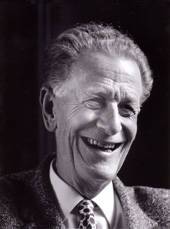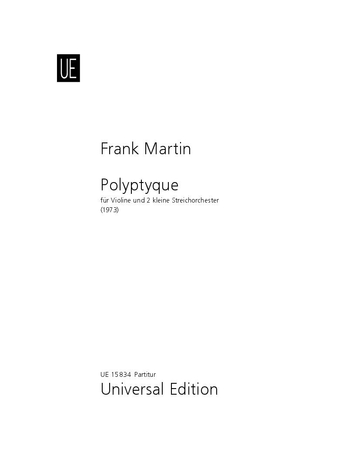

Frank Martin
Polyptyque
Duration: 25'
Dedication: Dédié à Jehudi Menuhin, au Zürcher Kammerorchester et à son chef Edmond de Stoutz.
Solos:
violin
Instrumentation details:
violin I (+A)
violin I (+B)
violin II (+A)
violin II (+B)
viola (+A)
viola (+B)
violoncello (+A)
violoncello (+B)
double bass (+A)
double bass (+B)
Martin - Polyptyque for violin and 2 small string orchestras
Printed/Digital
Translation, reprints and more

Frank Martin
Martin: PolyptyqueOrchestration: für Violine und 2 kleine Streichorchester
Type: Partitur (Sonderanfertigung)

Frank Martin
Martin: Violine soloOrchestration: für Violine und 2 kleine Streichorchester
Type: Solostimme(n) (Sonderanfertigung)
Print-On-Demand
Sample pages
Audio preview
Work introduction
Polyptyque is considered a 20th-century masterpiece, regularly performed worldwide since its premiere in 1973. Martin was commissioned to compose the piece by Yehudi Menuhin for the 25th jubilee of the Internationalen Musikrat. Says Menuhin (who was the soloist for the first performance), “When I play Martin’s Polyptyque, I feel the same elevation of soul as with Bach’s Chaconne.”
Martin – who, toward the end of his life, increasingly turned to religious subject material – took a polyptychon from Sienna as the basis for his composition. Choosing six panels of the Passion, he turned them into sensitive and profound music, his inspiration audibly from his deep empathy with Johann Sebastian Bach, in particular the St. Matthew Passion.
Translated by Grant Chorley
From the preface of the Repertoire Explorer Miniature Score:
Frank Martin and Arthur Honegger are the towering figures among Swiss composers of the twentieth century. Both hailed from Francophone Switzerland, both espoused a seriousness of purposes rooted in their Calvinist surroundings, and both excelled in large-scale works for chorus and orchestra that owed much to the example of Bach. At a time when Schoenberg’s dodecaphonic method was known only to a few close disciples and initiates, Martin undertook a deep study of the technique in the early 1930s and adapted it to his own compositional needs. The results were triumphantly presented in his oratorio Le Vin herbé on the Tristan legend, the work which first brought him to international attention. If his fame today mainly resides in this and other large-scale vocal works, especially the oratorio Golgotha, he nevertheless brought forth a large body of superior instrumental music, of which the Petite symphonie concertante, a work commissioned and premièred by Paul Sacher that has become perhaps his best-known piece altogether, may serve as a supreme example.
Toward the end of his life Martin was approached by the great violinist Yehudi Menuhin, then president of International Music Council, and asked to compose a work for the organization’s twenty-fifth anniversary. Martin, who had increasingly turned to religious themes (even in his instrumental music), accepted the commission and conceived a work based on a “polyptych,” a set of small medieval painted panels in Siena depicting the Passion of Christ. Of these, he selected six panels to form the basis of a multi-movement work for solo violin and double string orchestra. The movements bear the following titles:
1) Image de Rameaux (Palm Sunday) 2) Image de la Chambre Haute (The Last Supper) 3) Image de Jude (Judas) 4) Image de Géthsémané (Gethsemane) 5) Image de Jugement (The Judgment) 6) Image de la Glorification (The Glorification)
As the scoring for paired string orchestras suggests, Martin drew inspiration for the new work from Bach's St. Matthew Passion, a work that had profoundly impressed him at the age of twelve. The solo violin was roughly given the roles of both Jesus and the Evangelist, while the orchestras takes on the part of the Apostles or the turbae, the crowd scenes of traditional Passion settings. The Crucifixion itself was rendered in the fourth movement with extended writing for unaccompanied violin deliberately patterned after Bach's famous Chaconne. To underscore the Glorification of Christ in movement 6, a set of tubular bells was added to reinforce the impact of the harmony. The completed piece bears a dedication to Yehudi Menuhin, who also played it at its première in Lausanne on 9 September 1973, with Edmond de Stoutz conducting, to open the anniversary celebrations of the International Music Council. Since then the Polyptyque has been performed all over the world and recognized as a masterpiece of twentieth-century music. At the time of its première, Menuhin paid just tribute to its lofty aims and purpose: “When I play the Polyptyque by Frank Martin, I feel the same responsibility, the same exaltation as when I play Bach's Chaconne.”
Bradford Robinson, 2005
For the Repertoire Explorer Miniature Score please contact Musikproduktion Jürgen Höflich.
